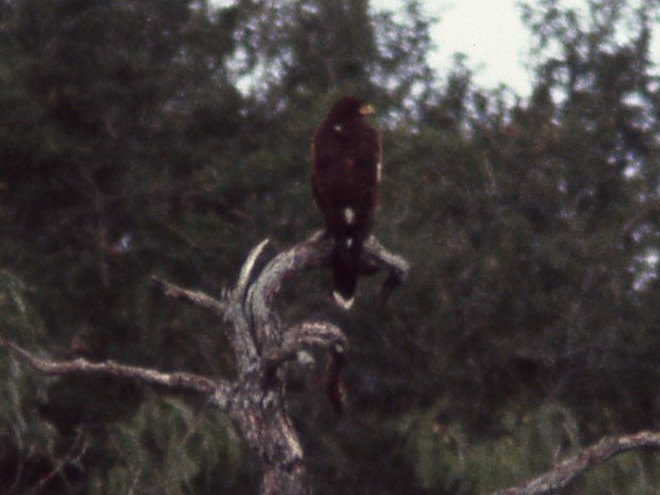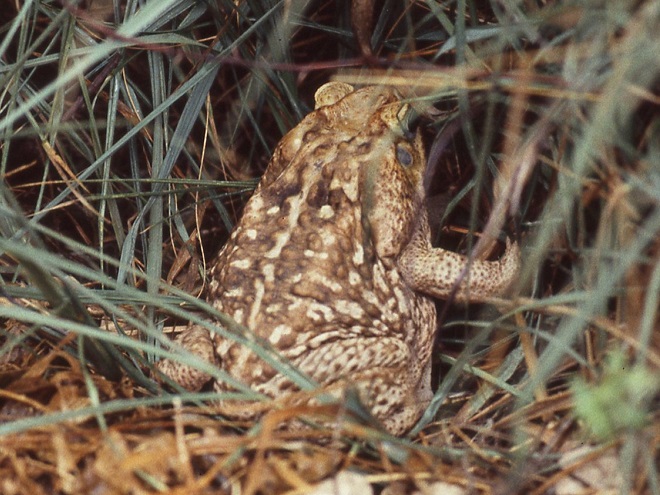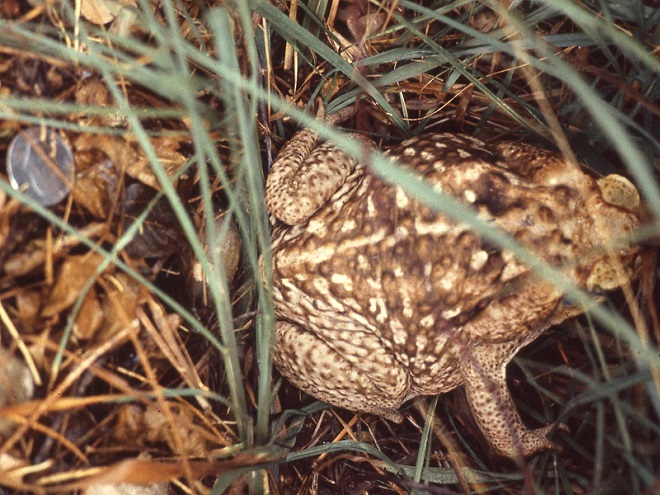Back in late May of 1983, four members of the Lancaster County Bird Club—Russ Markert, Harold Morrrin, Steve Santner, and your editor—embarked on an energetic trip to find, observe, and photograph birds in the Lower Rio Grande Valley of Texas. What follows is a daily account of that two-week-long expedition. Notes logged by Markert some four decades ago are quoted in italics. The images are scans of 35 mm color slide photographs taken along the way by your editor.
DAY SIX—May 26, 1983
“Bentsen State Park — Texas”
“Arose at 7:30. Birded the park and watched for the reported Roadside Hawk. No luck. A Roadrunner and Kiskadee was a welcome addition to our list.”
The appearance of Roadside Hawk (Rupornis magnirostris) north of the Rio Grande in Hidalgo County, Texas, was hot news in 1983. In the weeks leading up to our visit and while we were there, no sightings of this mega-rarity were confirmed. The reports that were received were not accompanied by photographs or sufficient details to rule out the Hook-billed Kites (Chondrohierax unicinatus) and Cooper’s Hawks that were known to be present. Roadside Hawk remains a very elusive tropical vagrant in the United States. It was seen as recently as December of 2018 along the man-made flood control levee to the east of Bentsen-Rio Grande Valley State Park near the Border Patrol Corral and the adjacent National Butterfly Center, neither of which were present in 1983.
Both the Greater Roadrunner (Geococcyx californianus), a familiar member of the cuckoo family (Cuculidae), and the Great Kiskadee (Pitangus sulphuratus), a flycatcher at the northern limit of its range in south Texas, were much anticipated finds at Bentsen-Rio Grande State Park. We would get better looks at both when we moved to the west in a couple of days.
“Traveled to Brownsville and met Harold and Steve at the airport at 12:30 P.M.”
Back in 1983, the Brownsville Airport was the most frequently used destination for those wanting to fly into the Lower Rio Grande Valley. Today, Valley International Airport in Harlingen is the busier of the two. Both of these airports have an interesting history from the World War II years. Brownsville Airport, renamed Brownsville Army Air Field for the duration of the war, was in use as a base for antisubmarine warfare flights, pilot training, aircraft engine overhauls, and the occasional servicing of B-29 bombers. The airport in Harlingen was founded during the period as Harlingen Army Air Field and was home to the Harlingen Aerial Gunnery School. A cheesy Hollywood propaganda movie called Aerial Gunner (1943) was shot there in late 1942 and starred Richard Arlen and a local actress, Amelita (Lita) Ward, who was discovered by the picture’s producers in Harlingen during the early stages of filming. A young Robert Mitchum portrays one of the gunners. It’s one of those typical B-movies of the period with a story line that is all mixed up with what happened years ago. A climactic part of the film depicts students being taken aloft to fire machine guns at kite-like targets being towed behind other training aircraft flying over the nearby Gulf of Mexico. You can find this classic and watch it for free on the internet. Afterward, you can go join up if you want, but you can no longer get the war bonds they were selling.
“We tried for the Clay-colored Robin — No Luck.”
Now that Harold and Steve had joined us, we began putting in an earnest effort to find the five species we all needed for our life lists—those Lower Rio Grande Valley exclusives Father Tom had given us directions to find. First up was Clay-colored Robin, known today as Clay-colored Thrush (Turdus grayi), a brown-colored bird similar to our American Robin. Its native range in 1983 was from northern Colombia north to the Rio Grande River. The only pair known to be reliably nesting north of the river in the United States, thus within the A.B.A. listing area, was in Brownsville in a park-like setting on the side of a small hill with a commercial radio station transmitter and antenna on its crest. It was an easy place to find in the otherwise flat landscape, but we had no luck finding the birds. Were we too late? Was nesting season over? Had the birds already dispersed?
“Visited Santa Ana again and added Ground Dove and White-tailed (Black-shouldered) Kite.”
Father Tom provided us with a tip that Hook-billed Kites had nested in the vicinity of Santa Ana National Wildlife Refuge. We remained vigilant, but saw none. The petite Common Ground Dove (Columbina passerina) was harder to locate than I expected, possibly because its small size makes it more prone to depredation than larger doves and pigeons, so it may be a little more secretive. White-tailed Kite (Elanus leucurus) sightings were a highlight of the trip, so graceful and stunning in appearance, but very wary and distant—not a good photo opportunity. Other sightings at Santa Ana included the first Harris’s Hawk (Parabuteo unicinctus) of the trip, White-tipped Dove, Groove-billed Ani, Barn Swallow, Black-crested Titmouse, Long-billed Thrasher, a lingering Solitary Vireo, Bronzed Cowbird, Olive Sparrow, and Northern Cardinal. We heard a Dickcissel (Spiza americana) in a sunflower field by the refuge entrance, but failed to see it.

Also at Santa Ana N.W.R. a Giant Toad and a Texas Tortoise (Gopherus berlandieri), a scrubland native of south Texas and northern Mexico.


“We arrived back at Bentsen State Park and I got supper ready while the others birded. At dusk we saw the Elf Owls again and toured the roads. Saw two Pauraques. To bed by 11:15 after a welcome shower.”
A White-eyed Vireo was found during our late afternoon walk. On a tip from Father Tom, we checked the campground in the area of the east restrooms for nesting Tropical Parulas (Setophaga pitiayumi). For each of us, it was another of the five target species for the trip. We heard nothing that resembled this warbler’s song, which sounds very much like that of the Northern Parula with which we were each familiar.
Nightjars are more often seen than heard, so having the opportunity to finish the day watching two Common Pauraques sail across a break in the forest to grab airborne insects was a real treat.
